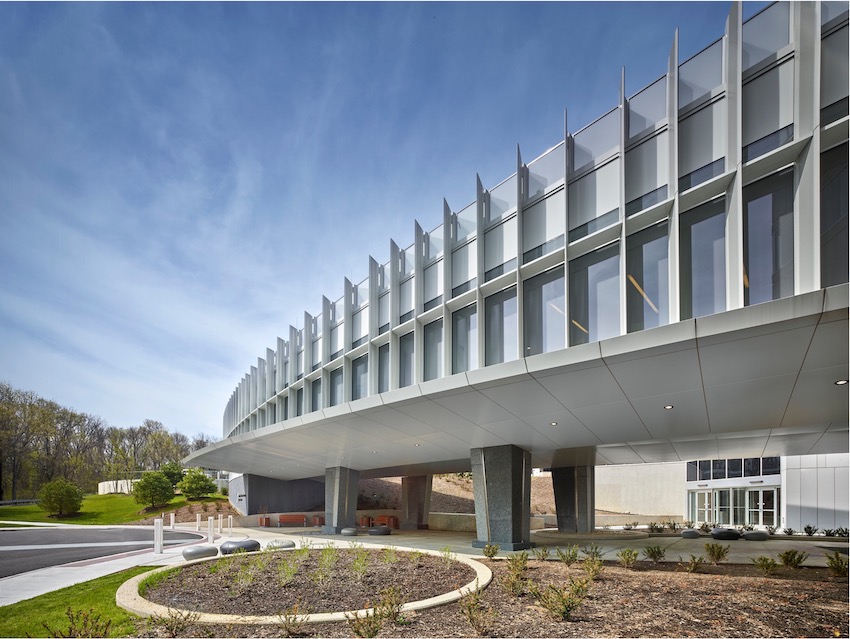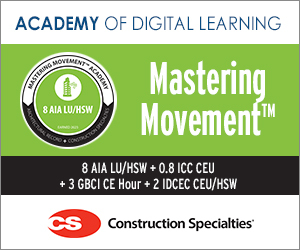Accommodating Movement in Building Design
 1 AIA LU/HSW; 0.1 ICC CEU; 0.1 IACET CEU*; 1 AIBD P-CE; AAA 1 Structured Learning Hour; This course can be self-reported to the AANB, as per their CE Guidelines; AAPEI 1 Structured Learning Hour; This course can be self-reported to the AIBC, as per their CE Guidelines.; MAA 1 Structured Learning Hour; This course can be self-reported to the NLAA.; This course can be self-reported to the NSAA; NWTAA 1 Structured Learning Hour; OAA 1 Learning Hour; SAA 1 Hour of Core Learning
1 AIA LU/HSW; 0.1 ICC CEU; 0.1 IACET CEU*; 1 AIBD P-CE; AAA 1 Structured Learning Hour; This course can be self-reported to the AANB, as per their CE Guidelines; AAPEI 1 Structured Learning Hour; This course can be self-reported to the AIBC, as per their CE Guidelines.; MAA 1 Structured Learning Hour; This course can be self-reported to the NLAA.; This course can be self-reported to the NSAA; NWTAA 1 Structured Learning Hour; OAA 1 Learning Hour; SAA 1 Hour of Core Learning
Learning Objectives:
- Explain how to manage movement in product specifications to protect the welfare of building inhabitants.
- Discuss building science terms around movement and the ways in which emerging trends lead to occupant health and well-being.
- Describe how design-assist consultants should help with early planning for better design and more efficient collaboration among all shareholders.
- List ways manufacturers are offering more services to ensure their solutions meet safety standards, aesthetic preferences, and performance requirements.
This course is part of the Mastering Movement™ Academy
The construction industry has always had to deal with weather events. In fact, it is one of the biggest factors in determining material choices, project plans, and strategies as well as labor and construction timelines. In the past few decades, however, natural disasters have increased and intensified in significant ways.
Data compiled by the U.S. government's National Oceanic and Atmospheric Administration shows that the number of earthquakes per year has seen significant variation, but the overall trend shows an increasing frequency. Engineering the seismic safety of buildings requires consideration for design, construction, and location. Buildings must be able to handle both major and small-but-perpetuating traumas, whether from a natural disaster due to climate change or some other weather event born of wind, sun, water, fire, or the earth, or whether it is the impact of occupants in and around the building.
In this presentation we look at how the earth’s elements impact building movement and how the built environment can be responsive to those impacts. Mastering movement means designing buildings with movement in mind and choosing products that can provide better health, wellness, and safety for occupants no matter what the outside environment conjures up.
The course will look at products designed for movement, explore new trends, and delve into the ways in which manufacturers and design consultants can help make good movement decisions every step of the way via collaboration and in service to better more sustainable construction.

Photo courtesy of Construction Specialties
 |
Founded in 1948, Construction Specialties (CS) is a specialty building products manufacturer. CS provides solutions to complex challenges architects, designers, building owners, facility managers, and contractors face every day. Since inventing the first extruded louver, CS has become a global leader in interior wall protection, impact-resistant doors, entrance mats & grids, expansion joint covers, architectural louvers & grilles, sun controls, explosion & pressure relief vents, cubicle curtains & tracks and stairs, awnings & balconies. CS draws upon extensive expertise to design high-quality products—many of which are Cradle to Cradle Certified™ Products Program. For more information please visit: c-sgroup.com |






